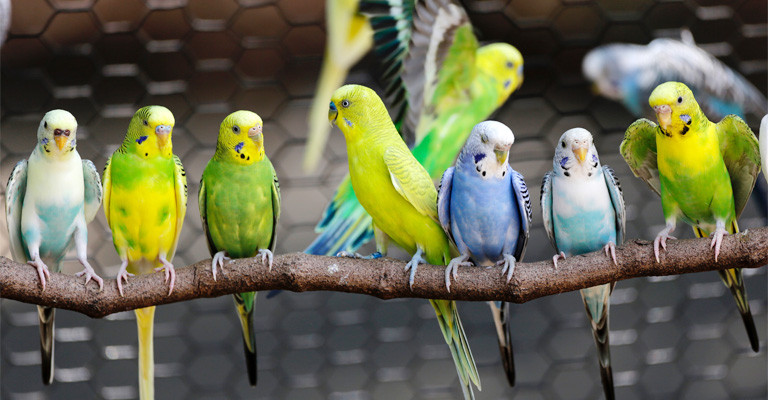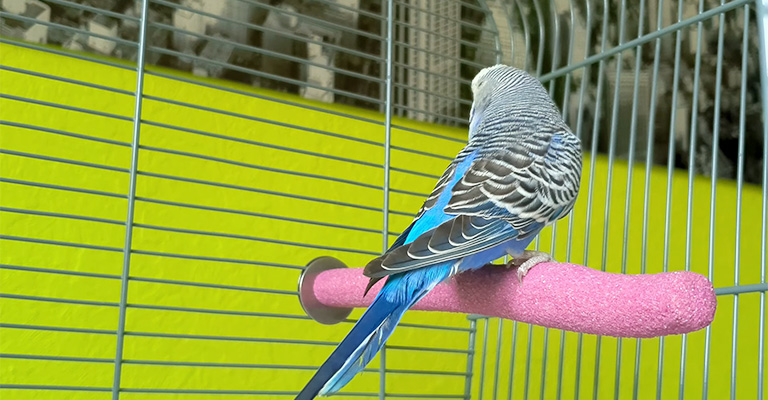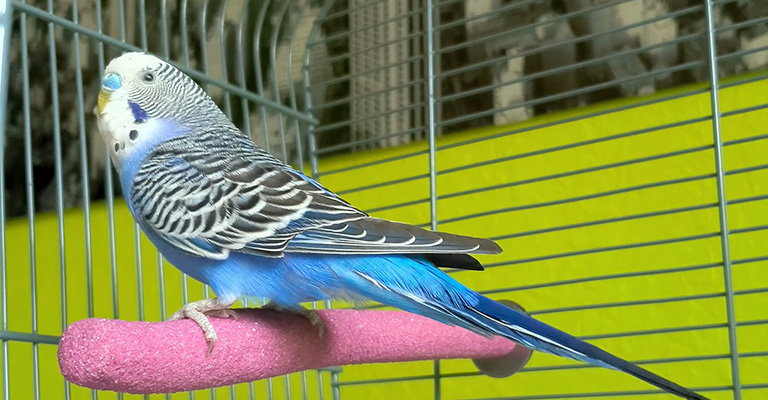Parakeets, those colorful, chatty companions that grace countless households around the world, are more than just vibrant ornaments in our lives. They possess a hidden talent that has captivated bird enthusiasts for generations – whistling. Have you ever wondered why do parakeets whistle?
In this exploration, we dive into the fascinating world of parakeet whistling, unraveling the science, psychology, and cultural significance behind this charming avian behavior.
Beyond their vibrant plumage and playful personalities, parakeets have a unique ability to mimic sounds, from household noises to melodies. But what drives this seemingly musical inclination in these small parrots? Join us on a journey to understand the purpose of their tunes.
As we embark on this journey, we’ll discover that there’s more to parakeet whistling than meets the ear. So, let’s spread our wings of curiosity and soar into the enchanting world of parakeets and their captivating melodies.

Why Do Parakeets Whistle?
Beyond their vibrant plumage and playful personalities, parakeets have a unique ability to mimic sounds, from household noises to melodies. But what drives this seemingly musical inclination in these small parrots?
Join us on a journey to understand the purpose of their tunes, whether it’s communication, mating rituals, or simply an expression of joy.
A Form of Communication
One of the primary reasons parakeets whistle is to communicate with each other. These social birds live in flocks, and whistling serves as a means to stay connected. They use a variety of chirps, clicks, and melodies to convey different messages.
Parakeets often whistle to alert their flock to potential threats. In the wild, this can include predators such as hawks or snakes.
By emitting a distinct warning whistle, one parakeet can quickly communicate danger to the entire group, enabling them to take evasive action.
On a more cheerful note, parakeets also use whistling to bond with their fellow flock members. These songs and melodies create a sense of togetherness and reinforce the social bonds within the group. It’s akin to humans conversing and laughing to strengthen relationships.
A Sign of Happiness
Have you ever noticed your pet parakeet whistling when they are content? It’s not a coincidence. Whistling is often a sign of a happy and relaxed parakeet.
When your feathered friend feels safe and comfortable in its environment, it may burst into song as an expression of joy.
This behavior is more commonly observed in well-cared-for, healthy parakeets. Providing them with a stimulating and enriching environment, along with social interaction, can lead to more frequent and varied whistling.
A Mating Ritual
In the world of parakeets, whistling also plays a role in the intricate dance of courtship and mating. Male parakeets are known for their elaborate and melodious serenades when trying to impress a potential mate.
During courtship, male parakeets will often perform a series of whistles and songs, showcasing their vocal prowess. This display of musical talent is an essential part of attracting a female companion.
If the female is impressed, she may respond with her own vocalizations, creating a duet that can be quite mesmerizing to witness.
A Cultural Connection
Beyond their natural behaviors, parakeets have won a special place in the hearts of humans for their ability to mimic sounds, including human speech and music. This talent has led to parakeets being cherished as pets for centuries.
Throughout history, parakeets have been kept as companions and entertainers. In ancient cultures, they were admired for their ability to mimic human speech and sounds. In some societies, they were even believed to bring good luck and fortune.
Today, parakeets continue to enchant people of all ages with their mimicry. Many pet owners delight in teaching their parakeets to whistle familiar tunes, creating a unique form of musical collaboration between humans and birds.
The Science Behind Parakeet Whistling

Now that we’ve explored the various reasons why parakeets whistle, let’s delve into the science behind this remarkable ability.
Vocal Learning
One of the key factors that enable parakeets to whistle is their capacity for vocal learning. Unlike many other birds that have fixed, genetically determined calls, parakeets have a remarkable ability to imitate sounds from their environment.
This ability is rooted in the complex vocal learning pathways in the brain. Parakeets have a well-developed area in their brain called the song control system, which allows them to mimic sounds with precision.
This system is analogous to the human brain’s language centers, demonstrating the sophistication of their vocal abilities.
The Role of Imitation
Parakeets are not born with their repertoire of whistles and songs. Instead, they learn these sounds by mimicking others. This can include other parakeets in their flock, as well as sounds they hear in their environment.
Interestingly, captive parakeets can also pick up sounds from their human caretakers. This is why you may find your pet parakeet mimicking your whistle or even speaking a few words if you consistently interact with them in this way.
What Are the Variabilities in Whistling?

One of the fascinating aspects of parakeet whistling is its variability. Parakeets can produce a wide range of sounds, from simple chirps to intricate melodies.
Their ability to modify and adapt their whistles showcases their vocal flexibility. The complexity of their whistles can vary not only between individual parakeets but also among different species of parakeets.
This diversity highlights the richness of avian communication and the unique vocal signatures of each bird.
Individual Variation
One of the most striking aspects of parakeet whistling is the individual variation that exists among these birds. Just as humans have distinct voices, each parakeet has its own unique whistling style.
This individuality in whistling is influenced by a combination of genetic factors, early learning experiences, and the bird’s environment.
Even within a single flock of parakeets, you’ll likely hear a chorus of different whistles and chirps, each bird contributing its own voice to the collective symphony.
This individual variation is a testament to the complexity of their vocal abilities and adds to the charm of having these birds as pets.
Species-Specific Variations
Parakeets come in a variety of species, each with its own distinct whistling patterns. These species-specific variations are often related to the regions where these birds are found in the wild.
For example, the Budgerigar, commonly known as the budgie, is one of the most popular pet parakeet species. Budgies are renowned for their high-pitched, cheerful chirps and melodies.
Their whistling often includes rapid sequences of notes and trills. In contrast, the Indian Ring-Necked Parakeet, another popular species, produces deeper, resonant whistles with a slower tempo.
The diversity in species-specific whistling patterns showcases the adaptability of parakeets to their respective environments and social dynamics.
Cultural Influences
Parakeets are known for their ability to mimic sounds from their environment, including human speech and music. This remarkable capacity for mimicry allows them to pick up and incorporate cultural sounds into their repertoire.
In households where parakeets are kept as pets, they may learn to whistle specific tunes or phrases based on their exposure to human sounds.
If a parakeet owner frequently whistles a particular melody or tune, the parakeet may attempt to mimic it. This cultural influence can lead to amusing and endearing moments as your pet parakeet engages in a musical dialogue with its human companions.
Age and Learning
The age of a parakeet can also influence the variabilities in its whistling. Young parakeets are often more receptive to learning new sounds and may be more inclined to mimic sounds they hear in their environment, including the whistles of other parakeets or household noises.
As parakeets mature, they may develop their own unique whistling style based on the sounds they’ve learned during their early stages of life. This developmental aspect adds another layer of variability to their whistling abilities.
The Influence of the Environment
The environment in which a parakeet is raised and lives play a significant role in shaping its whistling abilities. Parakeets that grow up in quiet environments with limited exposure to various sounds may have simpler and less diverse whistling repertoires.
On the other hand, parakeets raised in stimulating and enriched environments with exposure to diverse sounds are more likely to develop complex and varied whistling patterns.
Social interaction with other parakeets and human companions can also influence the diversity of their whistling.
FAQs
What Do Parakeets Eat?
Parakeets primarily eat a diet of seeds, supplemented with fresh fruits, vegetables, and the occasional treat. A high-quality commercial parakeet seed mix, along with fresh water, is essential for their daily nutrition. Leafy greens like spinach and kale provide additional nutrients.
How Can I Train My Parakeet to Whistle a Specific Tune?
Training your parakeet to whistle a specific tune can be a fun and rewarding experience. Start by whistling the desired tune consistently around your parakeet. Use positive reinforcement, such as treats, to reward your parakeet when it attempts to mimic the tune.
Do All Parakeets Whistle?
While many parakeets have the capacity to whistle, not all of them do so. Whistling behavior can vary among individual parakeets. Factors such as age, environment, and social interaction influence whether a parakeet will develop whistling abilities.
Are Parakeets Social Birds?
Yes, parakeets are highly social birds. They thrive in the company of other parakeets and often form strong bonds with their human caretakers. Social interaction is crucial for their mental and emotional well-being.
How Can I Keep My Parakeet’s Whistling Stimulating and Varied?
To keep your parakeet’s whistling stimulating and varied, provide an enriched environment. Offer a diverse selection of toys, including ones that make noise or encourage physical activity.
Play music or have the television on in the background to expose your parakeet to different sounds.
Conclusion
In the realm of nature’s symphony, parakeets prove to be virtuoso performers, captivating us with their melodious whistling. As we conclude our exploration into the “Why Do Parakeets Whistle?” mystery, several key insights have come to light.
Firstly, it’s clear that parakeets whistle not just for the sheer pleasure of it, but also as a form of communication. These avian virtuosos use their whistles to bond with their flock, attract potential mates, and even alert others to potential dangers.
Additionally, the cultural significance of parakeet whistling cannot be overlooked. Throughout history, these birds have been prized for their ability to mimic human sounds and tunes, earning them a special place in our hearts and homes.
In essence, parakeets’ whistling is a testament to the incredible adaptability and charm of these avian companions. As they serenade us with their sweet melodies, they remind us of the beauty that can be found in the smallest of creatures.